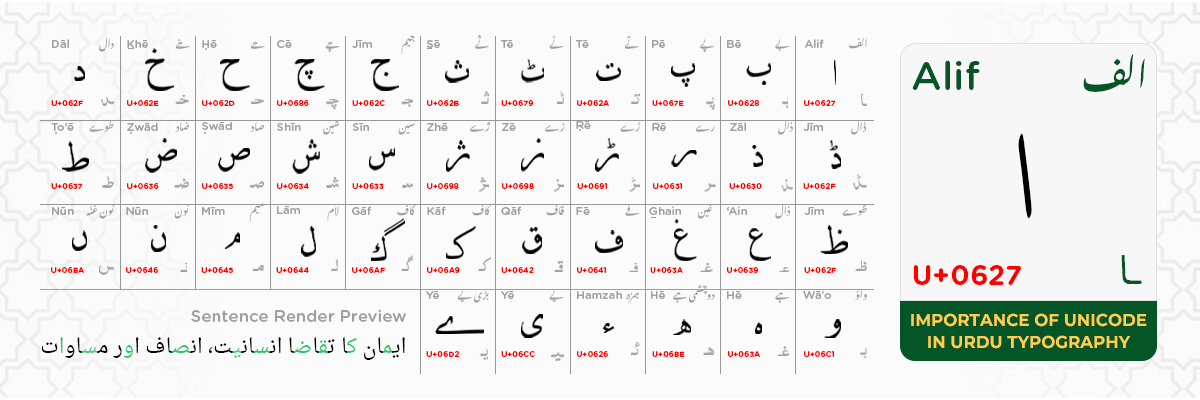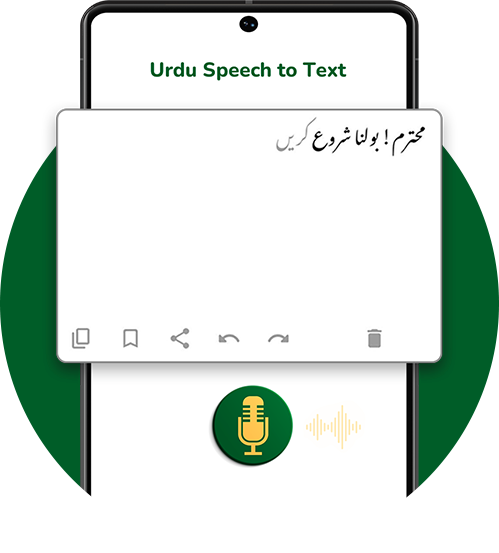Unicode is basically a universal system that makes it possible for computers to represent and handle text in almost every language in the world. For the Urdu typography, Unicode plays a great role. It ensures that Urdu text can be written, displayed, and shared seamlessly across different platforms and devices.
In this article we will explore what Unicode is, why it is important, and how it has transformed Urdu typography into a modern and accessible medium. Let’s get into the details now.
What are the best tools available for designing custom Urdu fonts? Here are 8 of the best tools to design custom Urdu fonts.
What Exactly is Unicode?
Unicode is a global standard. It is used for encoding, representing, and handling texts in computers and digital systems. Unicode was developed to overcome the limitations of older character encoding systems. Before Unicode, each computer system used its own set of characters and codes. This led to problems where text needed to be exchanged across different systems. Unicode solved all these issues. It assigns a unique number. The number is known as a “code point” to every character in every language. Here we are discussing specifically about the Urdu language so, let’s see some Unicode code points of Urdu alphabets.
- The Urdu letter “ا” has the Unicode code point U+0627.
- The Urdu letter “ب” has the Unicode code point U+0628.
- The Urdu letter “ا” has the Unicode code point U+0627.
- The Urdu letter “ب” has the Unicode code point U+0628.
These code points ensures that the same character appears correctly, no matter what software, device, or platform is used.
The Evolution of Unicode
Unicode has evolved over time. It accommodates an increasing number of characters and scripts. The Unicode Consortium is an organization that is responsible for managing Unicode. It regularly releases updates to add new characters and improve the standard.
- Unicode 1.0 was first released in 1991 with just 7,161 characters.
- Unicode 14.0 was released in 2021. It includes over 143,000 characters, including new emoji characters.
- Unicode 1.0 was first released in 1991 with just 7,161 characters.
- Unicode 14.0 was released in 2021. It includes over 143,000 characters, including new emoji characters.
The continued evolution of Unicode ensures that it can support the needs of future technologies and languages that emerge.
A Comparison Table Representing Urdu Typography Before and After Unicode
This table compares the challenges faced by Urdu typographers and digital users before and after the adoption of Unicode.
| Challenge | Before Unicode | After Unicode |
| Text Display Issues | Text was often corrupted or displayed incorrectly. | Text appears correctly on all devices. |
| Font Compatibility | Limited compatibility across devices. | Fonts work seamlessly across systems. |
| Language Input | Difficult to input Urdu on digital platforms. | Easy to input Urdu through online keyboards. |
| Cross-platform Sharing | Urdu text could not be shared across systems. | Urdu text can be shared and viewed globally. |
| Search and Accessibility | Urdu content was not searchable. | Urdu content is easily searchable online. |
How Unicode Works
Unicode works by assigning a unique code point to each character. It can then be stored and displayed by computers and digital devices. Here’s a simplified explanation of how it works:
- Text Encoding
When you type a character such as the letter “ب” your device translates that character into its Unicode code point U+0628.
- Storage
The device stores this code point in memory or on a file using an encoding format.
- Display
When the document or text is opened on another device, the Unicode code points are interpreted and rendered by the system’s font or display settings. It ensures that the character appears correctly.
How will AGA Cordoba V2 redefine digital Urdu typography for designers and creators? Let’s read more about it.
Unicode Code Points for Common Urdu Characters
This table list the Unicode code points for commonly used Urdu characters.
| Urdu Character | Character Name | Unicode Code Point |
| ا | Alef | U+0627 |
| ب | Be | U+0628 |
| پ | Pe | U+067E |
| ت | Te | U+062A |
| ج | Je | U+062C |
| چ | Che | U+0686 |
| د | Dal | U+062F |
| ر | Re | U+0631 |
| س | Seen | U+0633 |
| ہ | He | U+0647 |
Why is Unicode Important in Urdu Typography?
Unicode is important because it enables compatibility and consistency. It ensures accurate digital text representation. Let’s look at its benefits in the context of Urdu typography.
It has Standardized Text Representation
Before Unicode, text in Urdu often appeared incorrectly. This is due to the incompatible fonts or systems. Unicode ensures that Urdu characters are universally understood and rendered accurately on all devices.
Unicode has Cross-Platform Compatibility
When you write Urdu text using Unicode, it looks the same whether viewed on computer, smartphone, or tablet. This consistency is important for digital communications. It is more important if you are using Urdu typography for apps, websites, and social media platforms.
Seamless Search and Accessibility
Unicode makes Urdu text searchable. Whether it is a website or a document, you can easily search for Urdu words and phrases. This feature has boosted Urdu content visibility and accessibility a lot on the internet.
Enables Easy Typing and Display
Unicode enables better integration with modern world Urdu keyboards and software. When you are using Unicode font, typing will become easier. It has features like automatic word wrapping and correct alignment.
Common Urdu Fonts Supported by Unicode
Here are some of the common Urdu calligraphic fonts that are Unicode supported.
| Font Name | Type | Best For | Platform |
| Jameel Noori Nastaleeq | Nastaleeq (Calligraphic) | Elegant calligraphy, web and print | Windows, macOS, Web |
| Noto Nastaliq Urdu | Nastaleeq (Calligraphic) | Web content, blogs | Web, Android |
| Urdu Typesetting | Naskh | Official documents, books | Windows, macOS |
| Alvi Nastaleeq | Nastaleeq (Calligraphic) | Artistic projects, signage | Windows, macOS |
Unicode’s Impact on Urdu Typography
Urdu typography refers to how Urdu text is styled and presented. Unicode has transformed this field. It has made Urdu more adaptable in the digital world. Here are some of the ways in which Unicode has impact Urdu typography.
Beautiful and Legible Fonts
Unicode supports a variety of Urdu fonts, such as Nastaleeq, Naskh, and Ruqaa. Any of the designer can now create beautiful text layouts that remain clear and readable on all devices.
Responsive Websites Content
With Unicode, Urdu websites, blogs, and any other medium can display a dynamic and responsive text. Whether you are viewing on a mobile device or a large screen, the text will adjust perfectly with Unicode.
It has Better Integration in Apps and Software
Nowadays, there are different apps like MS Word, Adobe Photoshop, and even coding platforms that support Unicode Urdu text. This allows all Urdu language users to create Urdu content without worrying about the compatibility issues.
It has Enhanced Digital Urdu Content
The standards offered by Unicode have opened up new avenues for creating and sharing Urdu content on the internet. Different websites, blogs, and digital platforms can now present their content in Urdu. You not have to be worried about the technical issues that are associated with text encoding.
Unicode Facilitated Search and SEO in Urdu
With the introduction of Unicode, Urdu became fully searchable across all digital platforms. Before its creation, Urdu text was not encoded correctly. It was not even indexed or searched.
This limited its visibility online. Now, Unicode has resolved all these issues. This has also enhanced SEO for websites and businesses that are targeting Urdu-speaking audiences. It allows greater visibility for search engines.
| SEO Aspect | With Unicode | Without Unicode |
| Search Engine Indexing | Proper indexing and visibility | Difficult to index and display |
| Multi-device Display | Consistent appearance across devices | Display issues on some devices |
| Local Search Ranking | Better SEO ranking for Urdu content | Poorer ranking due to errors |
| User Experience | Accurate text rendering | Text may not appear correctly |
How does incorporating Urdu typography enhance the effectiveness and accessibility of educational software? Let’s read more about it.
Unicode Supports Urdu in Mobile and Messaging Platforms
As the mobile phones have taken a great rise, Unicode has revolutionized the way Urdu is used in everyday communication. The messaging platforms like Whatsapp, Telegram, and Facebook now support Unicode-based Urdu.
Long-term Compatibility
One of the most important aspects of Unicode is its compatibility. As new technologies will emerge, Unicode ensures that Urdu text will continue to be supported on these systems too.
Bottom Line
Unicode has revolutionized the way we handle languages. It has solved many challenges related to digital text display and encoding. Unicode plays a crucial role in making Urdu content more accessible and widely usable in the digital world. For anyone that is involved in Urdu typography, Understanding and using Unicode is important to create smooth, consistent, and accurate text across websites, apps, and digital media. By adopting Unicode, you can preserve the beauty and richness of the Urdu language. It ensures that the Urdu language thrives in the modern digital landscape.






